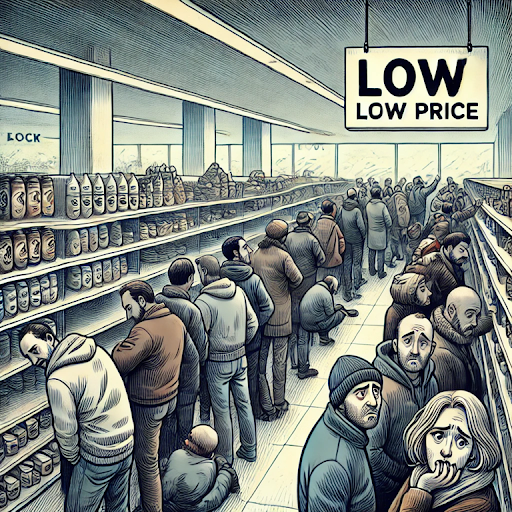The Ramifications of Price Control: A Double-Edged Sword
Price controls have been a tool used by governments throughout history to regulate the cost of essential goods and services, especially during periods of economic crisis or in industries deemed critical for public welfare. While the intention behind price controls is often noble, the actual consequences can be far-reaching, with impacts that stretch beyond the initial goals. This blog dives into the ramifications of price control, highlighting both the intended and unintended consequences.
What Are Price Controls?
Price controls are government-imposed limits on the prices charged for goods and services in a market. They typically take two forms:
1. Price Ceilings: These set a maximum price that can be charged for a product, preventing sellers from charging more than a government-set price.
2. Price Floors: These set a minimum price for goods or services, ensuring prices do not fall below a certain level.
Common examples include rent control in housing markets, minimum wage laws, and caps on the prices of essential goods like food and fuel during crises.
The Short-Term Benefits
In the short term, price controls can achieve some beneficial outcomes:
- Affordability: Price ceilings can make essential goods and services more affordable to low-income consumers, especially during periods of inflation or shortages.
- Stabilizing Markets: Governments often use price floors to support struggling industries. For example, minimum wage laws ensure that workers receive a livable income even when market forces might drive wages lower.
- Political Stability: During times of crisis, such as wars or pandemics, price controls can ease social unrest by ensuring the availability and affordability of critical goods.
However, as well-intentioned as these measures may be, the long-term impacts are where the complexities arise.
Unintended Consequences of Price Ceilings
1. Shortages: Perhaps the most widely recognized consequence of price ceilings is shortages. When prices are capped below the market equilibrium, demand often exceeds supply. Take rent controls, for example—while they make housing more affordable in the short term, they discourage new construction and maintenance, leading to housing shortages and deteriorating conditions.
2. Black Markets: Price ceilings can lead to the emergence of black markets, where goods are sold at higher prices than the official cap. Sellers who cannot legally charge enough to cover their costs may find under-the-table ways to sell their goods, undermining the original intent of the control.
3. Reduced Quality: To cope with the loss of revenue caused by price ceilings, producers may cut corners on quality. For instance, in the pharmaceutical industry, price controls can lead to reduced investment in research and development, ultimately affecting the quality and availability of drugs.
The Downside of Price Floors
1. Surpluses: Price floors, especially in agriculture, often result in surpluses. When the government sets a minimum price above the market equilibrium, producers may produce more than consumers are willing to buy. This often leads to wasted resources or expensive government intervention, such as purchasing excess stock to support prices.
2. Market Distortions: Minimum wages, a common example of a price floor, can distort labor markets. While they help ensure workers earn a basic living wage, they can also lead to unemployment if businesses reduce their workforce or automate processes to offset higher labor costs.
3. Barrier to Entry: For some industries, price floors create barriers to entry for smaller firms or new businesses. If the cost of adhering to a price floor is too high, competition dwindles, reducing innovation and choice for consumers.
The Long-Term Impact on Economic Efficiency
Price controls interfere with the price signals that guide efficient resource allocation in a market economy. In a functioning market, prices reflect the underlying costs of production and the value consumers place on goods and services. By distorting these signals, price controls often lead to misallocation of resources, reduced investment, and stunted economic growth.
Over time, these distortions can have widespread effects:
- Stifling Innovation: When profits are capped or prices are artificially inflated, businesses have less incentive to innovate or improve their products and services.
- Global Competitiveness: Price controls can reduce a country’s competitiveness on the global stage if domestic industries are shielded from competitive pressures, leading to inefficiency.
- Economic Instability: While price controls might stabilize prices in the short term, they can lead to greater instability in the long run as businesses and consumers react to shortages, surpluses, and shifting regulations.
Conclusion: The Trade-Offs of Price Control
Price controls serve as a stark reminder that economic interventions, while often motivated by good intentions, can have wide-ranging consequences. Policymakers must carefully weigh the immediate benefits against the long-term costs. In many cases, the market distortions caused by price controls lead to inefficiencies that can be more harmful than the original issues they sought to address.
As with any policy, the key lies in finding a balance—recognizing when and how to implement controls that genuinely serve the public good while minimizing the negative effects on economic efficiency and growth. Sometimes, addressing the root causes of market failures—such as improving competition, enhancing social safety nets, or directly supporting vulnerable populations—can be more effective than price controls themselves.
In essence, price controls are a double-edged sword. Understanding their full ramifications is crucial for anyone interested in how economics shapes the world we live in.




Comments
Post a Comment